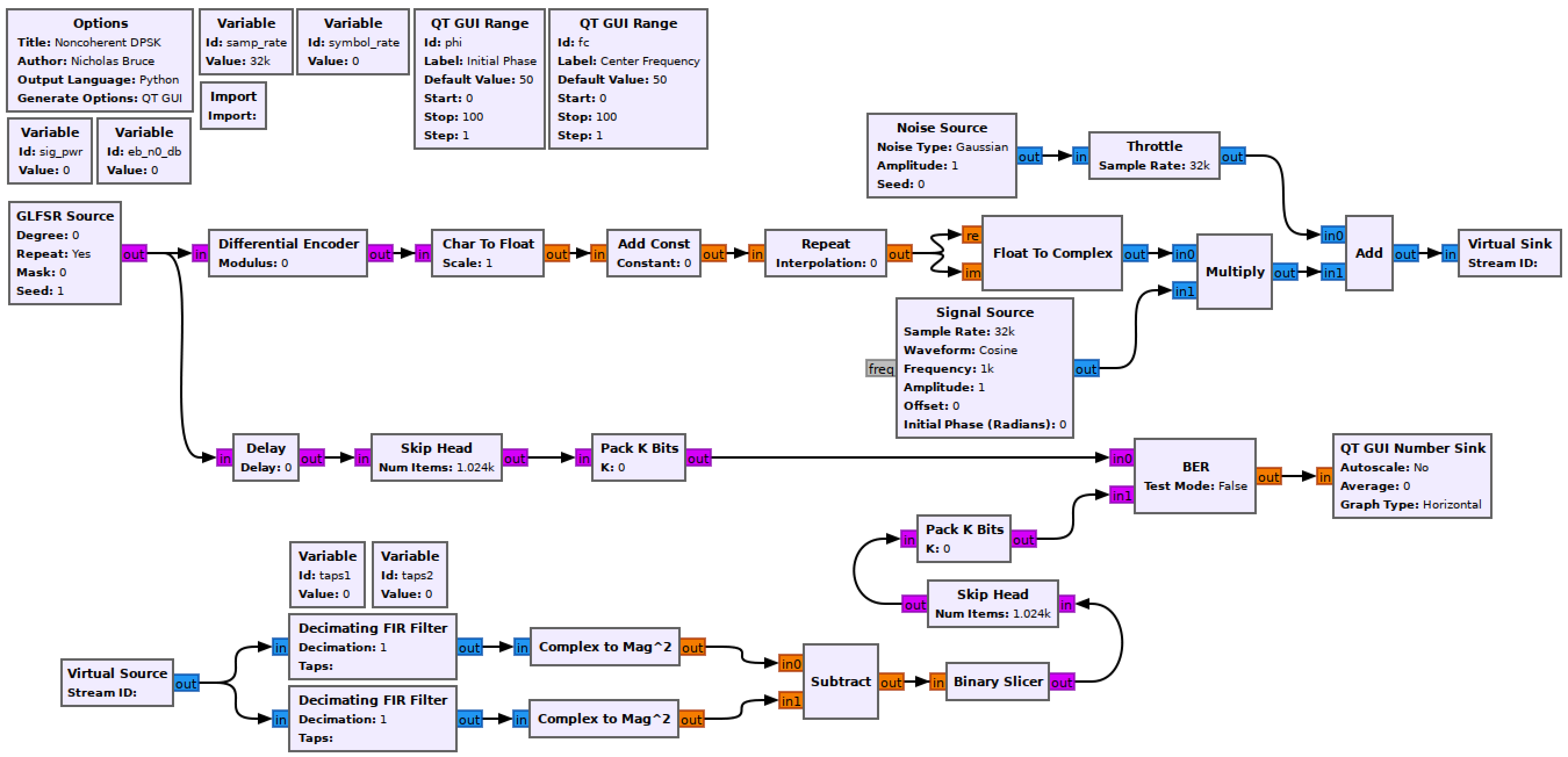Part 4 - Noncoherent DPSK
Objectives
You will implement a complex noncoherent baseband DPSK receiver.
Part 4 deliverables
For this section, the deliverables are:
- the answers to two deliverable questions,
- a dataset for later use in this lab.
Building the flowgraph
Construct the following GRC flowgraph. You can make a copy of the modulating flowgraph from the last section as a starting point by “Save As”-ing it.

Noncoherent DPSK simulation flowgraph.
Modulator
The modulator is largely unchanged excepting the addition of a Differential Decoder. The “Modulus” parameter is to indicate the size of the alphabet the stream is to be differentially encoded into. Set it to 2 so that the bitstream remains binary.
Variables
Add two new variables with the names taps1 and taps2. taps1 should be set to
np.ones((samp_rate//symbol_rate)) + 1j*np.ones((samp_rate//symbol_rate))
while taps2 should be set to -taps1. Each of these is \(1T\) of the modulated bitstream.
Decimating FIR Filter
Each of these is a matched filter for a two symbol periods. The filter will also decimate from M-samples-per-symbol to 1-sample-per-symbol. The upper is taps for [1, -1] and so should be set to
np.concatenate((taps1, taps2))
The lower is taps for [1, 1] and so should be set to
np.concatenate((taps1, taps1))
Ensure the “Decimation” parameter is set appropriately to bring the signal down to 1-sample-per-symbol.
Complex to Mag^2
These blocks take the envelope of the signal.
Binary Slicer
This block outputs a 0 for every negative input and a 1 for every positive output.
Delay
The Decimating FIR Filter causes a delay on the receiver signal chain. Use a 1 sample delay to align the signals.
Skip Head
Because of the filter, even once delayed the BER will take time to stabilize. This can be avoided by skipping the first part of each waveform before measuring the BER. Set the argument to 2048.
Pack K Bits
Set K to 8. This is the packet byte size that the later BER block requires.
BER
This computes the error between the two inputs. It outputs to log of the BER, so if it outputs a value of -2, the BER is \(10^{-2}=0.01\).
Set Test Mode to False, which will mean the block immediately starts outputting results (as opposed to waiting for the error rate to stabilize first). While Test Mode is False, the other parameters don’t do anything, so you can leave them as they are.
QT GUI Number Sink
This will draw the output of the BER block on a number line. Set the maximum to 0 (since \(10^0=1\) meaning that every bit is wrong) and the minumum to -7.
Run the experiment
- Run the flowgraph.
- Record the BER at \(\frac{E_b}{N_0}\) values of
[0, 2, 4, 6, 8]. You will need to kill the flowgraph each time you need to set a new value.- Plotting GUI sink values also eats computational power. While waiting for the BER values to stabilize you may wish to disable any unneeded QT GUI blocks.
- Put a QT GUI Time Sink and a QT GUI Constellation Sink at the end of the modulation chain to observe the transmitted signal waveform and constellation.
- Change \(\phi\) slowly and see that while the waveform changes, the BER value does not.
Deliverable question 3
It should be clear that since the \(\phi\) value does not change the BER that this is a noncoherent receiver. What are the advantages of implementing a physical system like this? In what scenario would a coherent receiver be necessary?
- Put a
0*in front of the Amplitude parameter of the Noise Source block. Slowly increase \(f_c\) and while observing the waveform and the BER, find the frequency offset at which the BER starts to rise.
Deliverable question 4
At what frequency offset does the receiver stop working and what is the corresponding phase-per-bit value?
At this point you should have recorded 5 BER values.
Review the section deliverables before moving on.
UVic ECE Communications Labs
Lab manuals for ECE 350 and 450